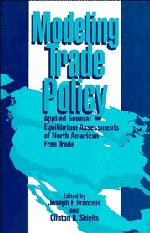Book contents
- Frontmatter
- Contents
- List of Contributors
- Dedication
- Part I Introduction
- Part II Multisector Models
- 2 A General Equilibrium Analysis of North American Economic Integration
- 3 The Gains for Mexico from a North American Free Trade Agreement – An Applied General Equilibrium Assessment
- 4 Some Applied General Equilibrium Estimates of the Impact of a North American Free Trade Agreement on Canada
- 5 Properties of Applied General Equilibrium Trade Models with Monopolistic Competition and Foreign Direct Investment
- Part III Sector-Focused Models
- Part IV Dynamic Models
- Index
5 - Properties of Applied General Equilibrium Trade Models with Monopolistic Competition and Foreign Direct Investment
Published online by Cambridge University Press: 25 March 2010
- Frontmatter
- Contents
- List of Contributors
- Dedication
- Part I Introduction
- Part II Multisector Models
- 2 A General Equilibrium Analysis of North American Economic Integration
- 3 The Gains for Mexico from a North American Free Trade Agreement – An Applied General Equilibrium Assessment
- 4 Some Applied General Equilibrium Estimates of the Impact of a North American Free Trade Agreement on Canada
- 5 Properties of Applied General Equilibrium Trade Models with Monopolistic Competition and Foreign Direct Investment
- Part III Sector-Focused Models
- Part IV Dynamic Models
- Index
Summary
Introduction
Applied general equilibrium (AGE) modeling has become the tool of choice in ex ante evaluation of international trade policy. However, economywide models frequently seem inscrutable to the outside observer and, in some cases, to the model designers themselves. It is sometimes difficult to untangle the economic mechanics underlying counterintuitive results.
For example, one of the more curious results from multicountry AGE models of a North American Free Trade Agreement (NAFTA) concerns the effect of economic integration on factor prices. Based on the Stolper-Samuelson Theorem, we might expect that the real return to at least one factor in each country will fall as a result of NAFTA. However, most of the general equilibrium models of NAFTA find that the returns to nearly all factors of production within North America rise. This is the case even for unskilled labor in the United States and capital in Mexico.
Analytical models generally provide an excellent guide to understanding AGE models in which goods markets are perfectly competitive. Factor market imperfections, such as a rigid real wage, easily account for the nonnegative Mexican rental rate effects in the models of Bachrach and Mizrahi (1992) and Roland-Hoist, Reinert, and Shiells (1992). National product differentiation, as in Hinojosa-Ojeda and Robinson (1991), and its associated term-of-trade effects played a role in maintaining the return to unskilled labor in the United States.
- Type
- Chapter
- Information
- Modeling Trade PolicyApplied General Equilibrium Assessments of North American Free Trade, pp. 124 - 148Publisher: Cambridge University PressPrint publication year: 1994
- 3
- Cited by



